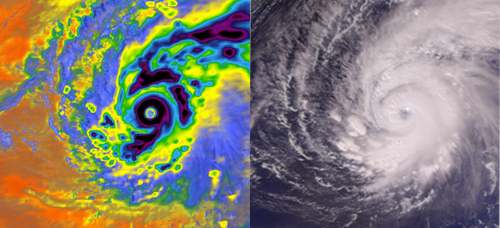
Supertyphoon Pongsona struck the U.S. Island of Guam on Sunday, December 8, 2002. The composite image (left) of the supertyphoon was made by overlaying data from the infrared, microwave, and visible/near-infrared sensors that make up the AIRS sounding system. This storm can also be seen with the standard AIRS Vis/NIR (right).
|
Welcome to the JPL Tropical Cyclone Information System
The JPL Tropical Cyclone Information System is being actively developed to help scientists improve their understanding and forecasting of hurricanes. It has two components: a set of near real-time portals that integrate model forecast with multi-parameter satellite and airborne observations from a variety of instruments and platforms, providing interactive visualization and some on-line analysis tools that work with both observations and models, and a 12-year global archive of multi-satellite hurricane observations.
Below you will find links to various portals where you can view different types of data.
|
|
|
|
North Atlantic Hurricane Watch (NAHW)
The North Atlantic Hurricane Watch data portal monitors hurricanes in the North Atlantic and East Pacific ocean basins. This near real-time interactive data portal was originally developed to support the multi-year Hurricane and Severe Storm Sentinel (HS3) aircraft campaign. HS3 was a five year mission with a three year airborne component (2012-2014). This portal allows users to analyze and compare observation data and model forecasts during each hurricane season (June - November) from 2012 to the present day.
|
|
|
Convective Processes Experiment - Aerosols & Winds (CPEX-AW) & Convective Processes Experiment (CPEX)
The 2021 NASA Convective Processes Experiment - Aersols & Winds campagin will study the dynamics and microphysics related to the Saharan Air Layer, African Easterly Waves and Jets, Tropical Easterly Jet, and deep convection in the InterTropical Convergence Zone (ITCZ).
The 2017 NASA Convective Processes Experiment (CPEX) aircraft campaign collected data that could help to answer questions about convective storm initiation, organization, and growth. This near real-time data portal was run from May to July of 2017 in support of the observational phase of CPEX. It collected data from satellite instruments and instruments flying on-board the campaign's DC-8 aircraft.
Additional information about both campaigns is available from the CPEX website.
|
|
|
The Cloud, Aerosol and Monsoon Processes Philippines Experiment (CAMP2Ex)
The Cloud, Aerosol and Monsoon Processes Philippines Experiment (CAMP2Ex) is a response for the need to deconvolute the fields of tropical meteorology and aerosol science at the meso-b to cloud level. Campaign operations were based at Clark International Airport (Philippines). The aircraft field campaign took place mid August - October 6, 2019 on the NASA P3 and the SPEC Learjet 35 platforms. To allow studies of the interannual variability and to put the CAPM2Ex mission observations in the context of this variability, the CAMP2Ex portal will collect satellite and model data over an extended period, including one year after the end of the field campaign. Additional information is available from the CAMP2Ex website. Data can also be downloaded directly from our data repository.
|
|
|
Tropical Cyclone Data Archive (TCDA)
The TCIS Data Archive is a comprehensive tropical cyclone database of multi-parameter satellite observations pertaining to the thermodynamic and microphysical structure of the storms, the air-sea interaction processes and the larger-scale environment. The TC Data Archive offers both digital data and imagery that are subset to the domain and time of interest, thus greatly reducing the volume of unwanted data. This makes the TCDA a valuable source to quickly build statistics in support of research, forecast improvement and algorithm development. Currently, the TCDA contains satellite depictions of hurricanes over the globe from 1999-2010. The data are organized by ocean basin, year and storm. As such, the TCDA provides an easy way to determine when coincident observations from multiple instruments are available – a very valuable and unique feature that saves researchers a significant amount of time dedicated to discovering the data alone. This web interface is now undergoing upgrades and is currently unavailable. Data can also be downloaded directly from our Tropical Cyclone Data Repository.
|
|
|